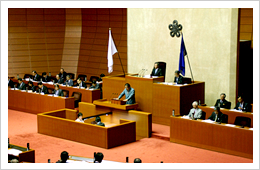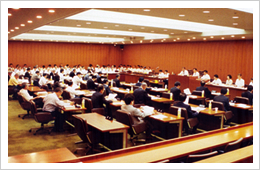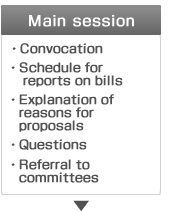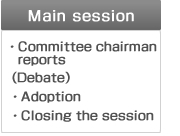The operations of the assembly
-
Delegates
-
The prefectural assembly consists of 87 delegates selected from 44 election districts.
A delegate’s term of office is four years. -
The chairman and the vice-chairman
-
The chairman and vice-chairman are chosen by election from among the delegates.
The chairman represents the prefectural assembly. He conducts the assembly sessions and strives to maintain order in the assembly chambers.
If the chairman is not present due to illness or other unforeseen circumstances, the vice-chairman will perform his duties in his stead. -
Regular and extraordinary sessions
-

There are four regular sessions of the assembly: in February, June, September, and December.
Extraordinary sessions are held as required.
-
The main session and committees
-
The conference for which all the delegates gather is called the main session. The final determination of the prefectural assembly is made here.
The work of the prefecture is wide-ranging and complex, so different committees are established to efficiently review in detail proposed legislation. The committees will deliberate and conduct surveys as necessary, even if the assembly is not in session.
Types of committees
The assembly steering committee
This committee deliberates on the handling of various matters required for resolutions, including the term of the session, the schedule of debate, extending the session, closing the session, establishing, augmenting, or abolishing special committees, and establishing, amending, or abolishing rules and regulations related to the assembly. In addition, it has been established for the smooth conduct of the sessions in consultation with the chairman.
Standing committees
Eight committees have been established for all the departments in the prefectural government.
They review legislative proposals, applications, and other matters during the session, and when the assembly is not in session, they review and examine items taken up for discussion during the main session.Special committees

These committees are established as necessary to review and examine specified issues.
There are six special committees at present. In addition, there is a special budget committee and account committee to review the prefectural budget and accounts.
Conference of representatives
This is composed of the chairman, vice-chairman, and at least five delegates that are members of the committees. They discuss matters related to events during the meetings, the number of delegates, the conduct of the first meeting after an election, and other matters required for the conduct of the meetings. It also reconciles the opinions of the different factions.
The flow of reviewing proposals

①Important topics are presented to proceed with the important work of the prefecture, including formulating and amending laws, the budget, and accounts. These are called bills.
The person submitting bills at the main session will explain the content of the bill and the reason for its submission.
②The delegates will ask questions about the bills and the work of the prefecture, and report the answers to the governor.
③The bills will be referred to committees for more detailed review.
④The committees will examine the referred bills, adopt measures after the conclusion of questions, and present the results of their examination.

⑤When the committee’s review is finished, the main session is convened once again. Bills are adopted after the committee chairman’s report on the review results.
Approval usually requires a majority of the delegates in attendance.

⑥The governor proceeds with the work of the prefecture based on the bills adopted in this manner.



